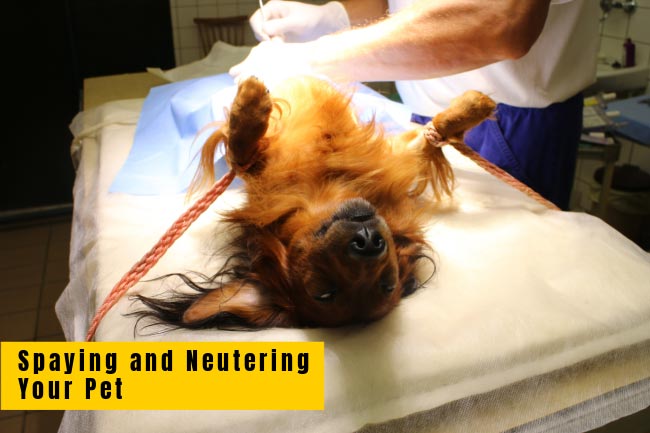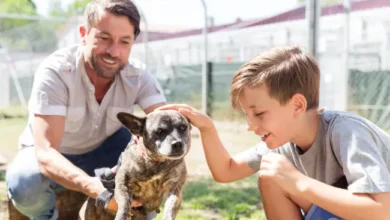
Signs your dog needs to be neutered!
Assuming you’ve as of late invited another dog or canine into your life. You may be contemplating whether you ought to have your canine buddy spayed or neutered. The following are replies to the absolute most normal inquiries individuals have about these medical procedures.

What is the contrast between spay and neuter?
Spaying. It includes the expulsion of the female canine’s uterus and the two ovaries through a cut made in the mid-region. However, a spay can likewise be performed laparoscopically (typically with ovariectomies).
Neutering. Neutering, or maiming, is carefully evaluating a male canine’s testicles. She likewise performed under general sedation. It is a less complex medical procedure than a spay. An entry point is made close to the front of the scrotum. Then, at that point, the gonads are taken out through that cut.
Why spay or neuter your dog?
Forestall impromptu young doggies.
On the off chance that your female canine is unspayed, she will come into rearing season or “heat” for half a month more than once per year. Each time this occurs, she’ll be highly harmful male dogs that can smell the fragrance from a long way off.
Then this can carry undesirable canine visitors to your yard and deliver a litter of spontaneous little dogs. Conveyance can now and then be troublesome and include exorbitant medical procedures or result in the deficiency of the bitch or young doggies.
The litter will likewise require veterinary consideration and shots after birth. In addition, observing great homes for pups can be highly challenging. Spaying and neutering is dependable method for forestalling unintentional reproducing, bringing about undesirable young doggies.
Reproducing should be passed on to raisers who have an organized arrangement. And also information about canine hereditary qualities. And who are worried about protecting a variety’s most desirable characteristics in the future. FunnyFuzzy provides the best dog spay or neuter for your favorite dog. So Dive into the connection and get better dog services from here.
Decrease of specific wellbeing chances.
Spaying or neutering can prompt a decrease in specific wellbeing gambles for both female and male dogs. Neutering a male canine forestalls malignant testicular growth and decreases various state sicknesses. And also, the neutered male dogs could likewise want to meander.
May assist with specific behavior issues.
As well as diminishing meandering in male dogs, neutering can occur regularly. However, it does not consistently help decrease or dispose of unwanted behaviors, for example, leg-lifting and mounting. Neutering may likewise diminish aggressive behavior in particular dogs. Spayed females are correspondingly less inclined to meander.
It’s important to note that new information proposes neutering before pubescence might impart a propensity toward bashfulness and erratic behavior.
What Can’t Dogs Eat
Dogs could want human food varieties; however, not all human food sources concur with them. Indeed, a portion of the food sources we eat can be harmful to our pets. The manners in which dogs’ bodies utilize food are different from how human bodies do. And also, understanding that a few food sources can hurt your puppy is a decent method for keeping the person in question safe.
While the food sources talked about beneath are not a comprehensive rundown of those that can hurt your pet. They are generally normal. If you have any inquiries regarding whether or not food is protected and you don’t see it on this rundown. However, you ought to decide in favor of alert.
The Food sources You Shouldn’t Take care of Your Canine
Alcohol, apple Seeds, Avocado, Cat Food, Chocolate, Espresso and Tea, Cooked Bones, Cob, Garlic, Grapes and Raisins, Bounces, Liver, Macadamia Nuts, Milk and Dairy, Onions Peppers, Organic product Pits, Any Crude Meat, Poultry, or Fish, Tomato Leaves, Salt, Sugar, Xylitol.
Winter Walking Tips for You and Your Canine
Climbing with your canine in winter is an excellent method for getting exercise in the colder months. However, rising in the winter is different from climbing with your canine mid-year. There are more risks and perils explicit to the season.
In any case, on the off chance that you and your canine are appropriately ready. And state-of-the-art on wellbeing tips, winter climbing with your dog can be loads of good times for both of you.
Dress for the Weather –
Think about a sweater or coat for little dogs or breeds with short covers. And boots or booties that can assist dogs with having proper footing on frosty surfaces.
Guarantee Legitimate Rope and Collar Fit –
Your canine’s choker or saddle should fit cozily. However, not excessively close, and the chain ought to be solidly joined. Check the collar and chain routinely to guarantee no brawls or weak points where the stuff could break.
Be Intelligent –
Pick a restraint, outfit, and chain with intelligent strips or decorations so your canine will be more noticeable in low light. Additionally, your jacket and other garments should be splendid colors for better permeability on short winter days when murkiness comes early.
Stick to Safe Courses –
Follow natural strolls and courses well away from perils or unknown territory that might Remain off newly salted regions to stay away from tainting on your canine’s paws. And consistently stay away from frozen water where the ice might be unsteady.
Know Your Canine’s Cutoff points –
Know about your canine’s general wellbeing, and focus on any indications of discomfort. Extremely youthful and ancient dogs are more defenseless against the cold. And also, specific medical issues, like joint pain, can be exacerbated by cold.
Shorten Strolls depending on the situation –
On freezing days, go for shorter strolls rather than long meanders. On the off chance that is essential, go for a few shorter hikes over the day rather than only one long trek to guarantee neither you nor your canine gets excessively cold during the walk.
Keep a Firm Hang on Your Canine –
Continuously keep a firm hang on your canine’s chain. Assuming circumstances are icy, consider binding the rope to your wrist or involving a clasp to affix it to your abdomen if you fall and could lose your hold.
Keep Your Canine’s Toenails Short –
Freezing conditions make toenails more inclined to break parts, particularly assuming they consistently rub on black-top or cement during strolls. Keeping your canine’s nails shorter in winter will limit this gamble and assist with forestalling contamination in the nails.
Give A lot of Water to Hydration –
Indeed, even on calm days, your canine can become dried out while working out. Be sure you offer a lot of new, clean water to keep your dog appropriately hydrated. And try not to allow them to eat ice or snow that could chill them from within.
Last Thought
Most importantly, be aware of your canine’s condition consistently, and realize when conditions might be icy for a winter walk. Extreme shuddering and hesitance to remain outdoors are sure signs that it is freezing for your canine to be outside. And also, it will be ideal for practicing with fun indoor games, all things being equal.
With legitimate safety measures, both you and your pet can appreciate winter strolls. And the skill to be careful and comfortable while practicing the entire winter.



